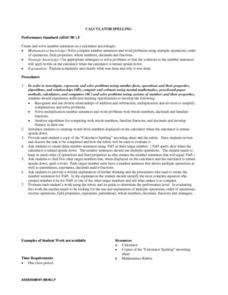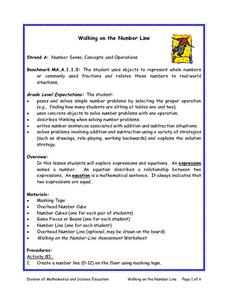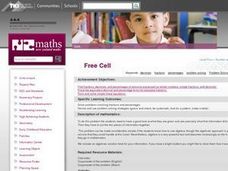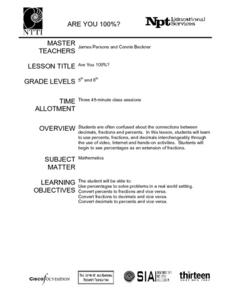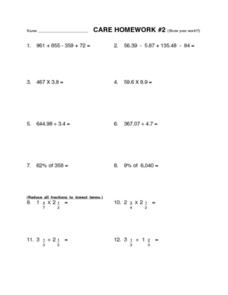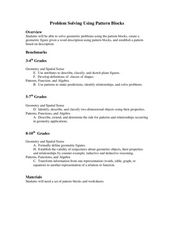Curated OER
Solutions
In this solutions activity, students calculate molality and mole fraction. Students define colligative property and determine what affects the solubility of gas in solvents. This activity has 2 short answer questions and 9 problems to...
Curated OER
Calculator Spelling
Sixth graders practice creating and solving number sentences on a calculator. They interact with number facts, their properties, algorithms and estimation. Each student recognizes inverse relationships of addition, subtraction,...
Curated OER
Walking On The Number Line
Young scholars investigate the concepts of expressions and equations while defining the similarities and differences. They explore the operations by using a number line and record answers while working with the teacher. Students play the...
Curated OER
Introducing the Concept: Percents
Students explore the math concept of percents. In this percents lesson, students examine visual examples of the relationships among fractions, decimals, and percents. Students also practice solving problems that their instructors model.
Curated OER
How Simple Is Your Rational Expression?
Investigate simplifying rational expressions. Learners define rational expressions, review how numerators and denominators are polynomials and complete several problems using a checklist to ensure they don't skip any steps. Work can be...
Curated OER
One Size Fits All, Part 1
Can you tell how tall someone is just by looking at their feet? In this activity, young mathematicians measure their height, arm span, and foot size, graph their findings, and answer questions about how these measurements are related....
Curated OER
Ratio and Proportion: Basic Operations and Applications
Learners explore example problems dealing with ratios and proportions. Afterward, they read story problems and solve them using ratios and proportions. This four-page worksheet contains six multi-step problems.
Curated OER
Building Sets of 13 and 14
Compose and decompose sets of 13 and 14 and compare sets of each with your little learners. They use objects to construct sets of 13 and 14, record their answers, and compare sets in several different ways.
Curated OER
Solving Linear Equations
In this linear equations worksheet, students solve linear equations for the variables with negatives and fractions. Students complete 28 problems.
Pennsylvania Department of Education
Adding Common Fractions
Fourth graders estimate various measurements. In this lesson on measurement, 4th graders estimate the length and mass of multiple objects. Students discuss the difference between a guess and a reasonable estimate and discuss using...
Curated OER
Free Cell
Fourth graders use algebra to begin solving a problem. The problem has a real world application to engage learners. The main skill is converting fractions and decimals. Also finding the right number sentence for the word problem is...
Curated OER
Are You 100%?
Students use decimals, fractions, and percents to solve problems in a real world setting.
Curated OER
Addition and Subtraction Pick n Mix 2
Fourth graders practice a wide range of strategies for solving addition and subtraction problems containing decimal fractions. They add and subtract fractions, decimals and integers while generalizing the properties of operations with...
New Zealand Ministry of Education
Fraction Bar
Computing class members encounter use a digital learning tool called The Fraction Bar to multiply fractions with whole numbers. They do so by finding a given fraction of a number either on a number line or by calculating the answer with...
Curated OER
Geometric Fractals and the Chaos Game
Students define fractals and patterns. They explore how a seemingly random process can result in a pattern. Students practice probability and fractions skills by playing the chaos game online.
Curated OER
Using Part To Whole
Students engage in a math lesson that is concerned with developing problem solving skills. They emphasize the cognitive reasoning of seeing parts as pieces to a whole. Writing is integrated into a cross-curricular study of math.
Curated OER
Making Change
Second graders explore how to incorporate a new type of technology, the cash register and/or a calculator, as a motivational tool for solving real life problems. They practice estimating money and counting back change from $20.00.
Curated OER
Care Homework #2
In this Care Homework worksheet, young scholars solve a variety of multiple digit addition, subtraction, multiplication, and division problems that include fractions, decimals, and percentages. They demonstrate knowledge of geometric...
Curated OER
Savings
Students investigate the different ways to save money and the reasons for doing so. They use addition, subtraction, multiplication, and division (with whole numberrs, fractions, decimals, and/or percents, mixed numbers) to solve...
Curated OER
Reading to Calculate
Students follow directions utilizing the Casio calculator to accurately solve calculations involving fractions in preparation for the math portion of the GED test. They stress the ability of reading instructions precisely and accurately....
Curated OER
Reversing Numbers
Second graders solve a math word problem involving the addition of two digit numbers. They discuss the problem as a class, independently explore the problem, and discuss as a class the solution and how they organized their reversed...
Curated OER
Summer Term Math Assessment
In this math instructional activity, students assess their math skills by completing a comprehensive instructional activity covering ordering and comparing numbers, place value, fractions, basic operations, word problems, geometry, time...
Curated OER
Problem Solving Using Pattern Blocks
Students use pattern blocks to create a figure that is described to them and establish a pattern based on the description of the geometric figure. In this pattern blocks lesson plan, students fill out shape and fraction worksheets.
Curated OER
Giggle, Giggle, Quack Pizza Fractions
Students explore the concept of multiplication by using pizza. They read an article discussing how math is used everyday. They try to determine how many pizzas they would need to feed the class.



